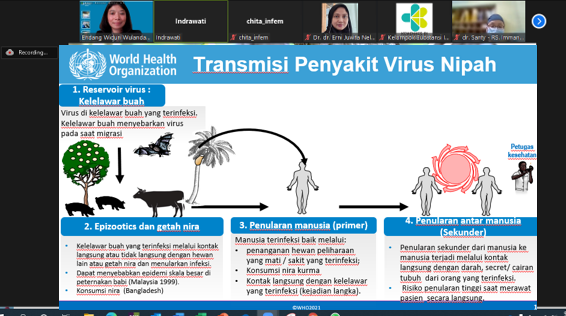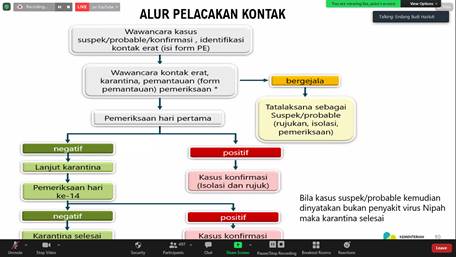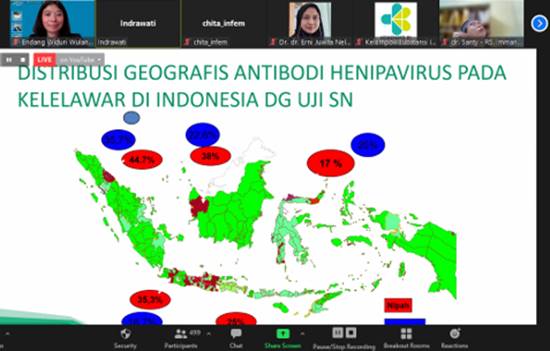While we are responding to the COVID-19 pandemic, there are also risks of other emerging infectious diseases (EIDs). Nipah virus disease is a zoonotic illness that can spread between animals and people as well as via contaminated food. Fruit bats of the Pteropodidae family are the natural hosts of the Nipah virus. Transmission through direct contact with infected animals (e.g., pigs or horses) and consumption of raw palm sap have been documented. Human-to-human transmission of Nipah virus was reported among families and caregivers of patients. In infected people, it causes a range of illnesses, from asymptomatic infection to acute respiratory illness and fatal encephalitis with an incubation period ranging from 4 up to 45 days. The case fatality rate is estimated between 40% to 75%. A research report in screening for Nipah virus infection in West Kalimantan province found 19% of the 84 Pteropus vampyrus bat sera tested positive. 
Fig. 1. dr Endang Wulandari (WHO) presented the Nipah virus transmission during a webinar organized by MoH, 9 December 2021 (Credit: Endang Wulandari/WHO).
As part of EID preparedness, WHO supported the MoH to develop a guideline on prevention and control of and a risk mapping tool through a series of consultation meetings with experts from multiple disciplines from MoH, professional associations, epidemiologists, infectious diseases hospitals, animal health and wildlife sectors, laboratory experts, Indonesian Ulema Council and risk communication. The guideline covers various topics such as epidemiology and aetiology, surveillance, laboratory diagnosis, clinical management, risk factor control and risk communication and community empowerment.

Fig. 2. dr Endang Budi Hastuti (MoH) presented Nipah surveillance. (Credit: Endang Wulandari/WHO).
On 9 December 2021, MoH held a webinar to disseminate the Nipah virus guideline. More than 500 participants from healthcare workers, provincial, district health officers and point of entry officers, animal health officers attended. The webinar covered the global situation, the virus disease risk in Indonesia, its operational definition, surveillance, case management, infection control including personal protective equipment and mortuary, laboratory diagnosis, risk communication and community empowerment.
- Epidemiology and geographic distribution of Nipah virus.
- Risk of spill over of Nipah virus from wildlife to domestic animals and further spread to humans.
- Lessons learned from Nipah outbreaks and response in neighbouring countries.
- Strategy for Nipah virus prevention and control.
- Recommended intensive supportive care to treat severe respiratory and neurologic complications.

Fig. 3. drh. Indrawati Sendow from Indonesian Research Center for Veterinary Science presented Nipah virus in animals. (Credit: Endang Wulandari/WHO).
WHO also supported MoH with MoA and MoEF to develop a risk mapping tool for Nipah. The tool considers variables and required data on hazard, exposure, and context capacity. These include virus characteristics, treatment, prevention, importation risk, probability of local transmission, economic impact, presence of bat population, bat movement, changes in the ecosystem, local culture and behaviour, the density of pig poultry, livelihood, mobility, the existence of wet markets, the presence of palm sugar plantations and mangroves, the capacity of health facilities, surveillance, and multisectoral coordination for EIDs using the one health approach.

Fig. 4. WHO presented the strategy for Nipah preparedness and control. (Credit: Endang Wulandari/WHO).
Learning from the COVID-19 pandemic, preparedness including contingency planning and risk mapping for emerging infectious diseases, such as Nipah virus is crucial to ensure prevention, early detection, and prompt response for containment measures.
***
WHO Indonesia is grateful for the support from the Australian government to its programme on enhancing emerging disease preparedness.





